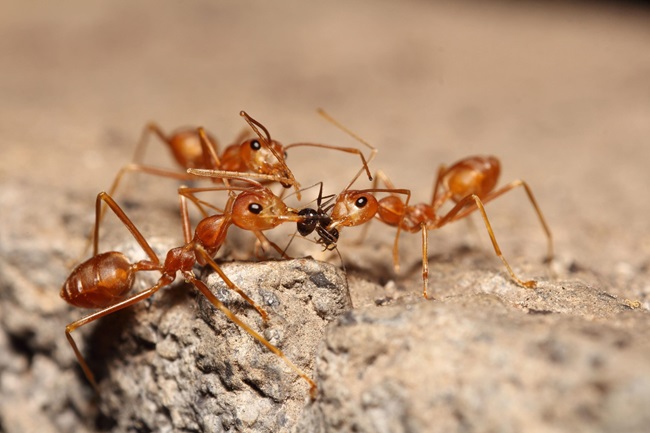
Fire ants are the type of pest that spell trouble for a garden and the people tending said garden. Good growers make sure to keep an eye on the inhabitants of their gardens and have pest control plans in place to cull invasive species, and fire ants get top billing due to the adverse effects fire ants have on humans. To clarify, we’re discussing Solenopsis invicta, also known as the red imported fire ant (RIFA), but we’ll continue to refer to this species as simply “fire ant” throughout this article.
Of course, fire ants were not always an issue in the United States. In fact, it’s entirely possible that you’ve lived in the USA your whole life and never encountered a fire ant. Fire ants originated in South America and are suited to a tropical climate. They do poorly in cold winters and when exposed to freezing temperatures, which confines them mostly to the Deep South in the United States. Smaller fire ant populations have also settled into Southern California, Arizona, and New Mexico.
The red imported fire ant made its way to US soil in the 1930s. While it is impossible to know the exact date that fire ants invaded the US, it is widely agreed that the fire ants were brought from South America to the US on trading ships. These ships used soil as ballast, unknowingly transporting fire ant colonies northwards. Eventually, one of these fire ant colonies escaped the hull of the cargo ship and onto US soil. At this point, the fire ant population exploded due to the lack of natural predators, and the ankles of those living in the Deep South have never been the same.
So, what happens when fire ants establish a colony on your property? How do you get rid of fire ants? In addition to the 14 million people who are stung by fire ants each year in the USA, fire ants also cause $6.7 billion in environmental and agricultural losses annually. They also crowd out beneficial insects and larger animals, such as ground nesting birds. Because of their lack of natural predators in the USA, there is no “wait-and-see” approach with fire ants. If you don’t take action, the problem will only get worse.
The first treatment is a home remedy that can be done by anyone with a bucket, though it is not perfect and requires favorable conditions. The process is simple: fill a bucket with 3 gallons (at minimum) of near-boiling water. Poke a hole in the fire ant mound – use a broom handle, not your finger – then pour this water into the mound. However, there are several issues to keep in mind when using this method.
- This method is only going to eliminate 40% (on average) of a fire ant population per application. You need to do this several times to have a good chance of killing the queen.
- The fire ant mound needs to be visible. While many mounds do appear as elevated clumps of dirt, not every fire ant mound is visible above ground.
- You need to locate the mound! Just because you have fire ants in your garden doesn’t mean that the mound is on your property. The dirt mound has no entrance. Instead, fire ant workers build tunnels that can extend several feet from the mound, emerging far away from their queen.
- Hot water will cause collateral damage to any plants that are nearby.
When dealing with fire ants, you can make some progress with homemade remedies, but we honestly recommend using a professional product. You aren’t just risking the health of your garden or lawn; you’re also risking the health of your family and pets. It’s best to eliminate fire ant colonies as soon as possible. Specialized products such as Orange Guard® Fire Ant Control can replace scalding water and are much more effective, lingering in the burrow and dissolving the exoskeleton of fire ants. It’s also safe to use around plants, unlike scalding water. Once the population has been reduced through a liquid pesticide, target the soil of the burrow to kill off the stragglers. Mix a product like Perma-Guard™ Crawling Insect Control into the soil to add diatomaceous earth to your yard. This is non-toxic to plants and larger animals such as birds or common household pets. The diatomaceous earth will absorb oils and fats from a fire ant exoskeleton, causing it to dry out and die.
Fire ants are a terrible problem to deal with. Luckily, it’s not an impossible problem. For fire ant and other pest control needs, visit ARBICO Organics for over 40 years of expertise in pest control solutions designed for professionals and hobbyists alike.




Comment here